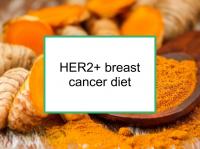A new study has reported that the marine omega-3 fatty acid docosahexaenoic acid (DHA) and the turmeric spice component curcumin act separately and in combination against a variety of breast cancer subtypes. Furthermore, the effects of DHA and curcumin are synergistic in HER2+ cells that are hormone receptor negative (ER-/PR-).
Breast cancer is a group of diseases with various biochemical characteristics. Therefore, possible treatments must be evaluated in the context of multiple breast cancer cell lines with known molecular phenotypes.
DHA (found in fatty fish such as salmon and in fish oil) and curcumin both are known to inhibit breast cancer cell proliferation. In the study, dose response curves were generated for curcumin and DHA in five breast cell lines. The effects of the DHA in combination with curcumin on cell proliferation were also assessed.
Curcumin in combination with DHA was found to have an antiproliferative effect in two HER2 overexpressing human breast cancer cell lines (SK-BR-3 and MDA-MB-361), triple negative breast cancer cells (MDA-MB-231), ER+/PR+ breast cancer cells (MCF-7), and pre-malignant breast epithelial cells (MCF10AT). The effect of treatment with curcumin plus DHA was synergistic in SK-BR-3 (ER-/PR-/HER2+) cells compared to the two compounds when tested separately. Curcumin plus DHA triggered disease-relevant cellular responses that for the most part did not overlap the changes caused by curcumin or DHA individually.
The effects of genes known to be involved in cell cycle arrest, cell death, inhibition of metastasis, and cell adhesion were enhanced, while the effects of genes involved in cancer development and progression, metastasis, and cell cycle progression were inhibited. DHA was observed to increase cellular uptake of curcumin in SK-BR-3 cells, but not in the other cell lines tested.
The authors conclude that the combination of DHA and curcumin may be an effective treatment for some breast cancers, depending on molecular phenotype. The compounds in combination exert antiproliferative effect across multiple breast cell lines, which are synergistic in SK-BR-3 cells and triggers cell signaling events not predicted by the activity of either compound alone.
